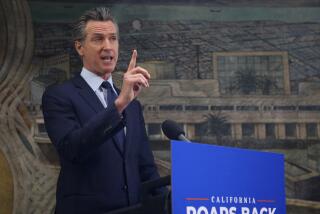A spending cap for California?
Today’s topic: While Sacramento does have a revenue problem, it also has trouble controlling spending. Given the Legislature’s utter inability to restrain spending in good years, shouldn’t any budget-reform measure contain a spending cap?
The myth of California’s ‘spending problem’
Point: Jean Ross
Today’s assigned question is a great example of the perils of relying on “conventional wisdom” that’s not supported by the facts. California does have an imbalance between revenues and expenditures, but the cause of that imbalance is largely on the tax side of the ledger. Over the last 15 years, the Legislature has approved tax cuts that cost the state about $12 billion a year. And the Legislature continues to cut taxes in bad times as well as good, reducing business taxes by about $2.5 billion a year in the last year alone, an amount almost equal to the general fund’s cost for the entire University of California system. Our long-term budget problems also reflect a tax system that has failed to keep up with a changing economy -- such as the relative shift from goods to services and the increase in often untaxed Internet sales.
While spending has increased over time, the growth in spending reflects demands imposed by a population that is growing, aging and becoming more diverse. In the last year alone, California has added more than 408,000 new residents, nearly equal to the population of Sacramento. And, critically important from a budgetary standpoint, the fastest-growing segment of the population is the elderly, increasing demands on health and age-dependent services. About 60% of the nursing home days in California, for example, are paid for by Medi-Cal, the publicly supported health program for low-income Californians.
California’s complex budgeting rules also make it difficult to separate the myths from the facts. I often remark that only in California does a $6-billion tax cut -- the late 1990s reductions in vehicle license fees -- show up in the state budget as an increase in school spending. And it does so because of laws and ballot measures that move dollars between the state, schools and local governments. No wonder voters are confused.
Finally, it’s important to remember that California does have a strict constitutional limit on state spending, one of the first and toughest in the nation. We’ve had one since 1979. And there’s little evidence to suggest that such limits protect against budget shortfalls. The two states with projected 2009-10 deficits worse than California’s -- Nevada and Arizona -- also have spending limits. Interestingly, Nevada and Arizona have something else in common with California: They also require more than a majority of the state legislature to approve some or all state tax increases. Four of the five states with the smallest shortfalls -- and virtually every state has one this year thanks to the weak economy -- have no limits on state spending.
So what would make a positive difference in California’s fiscal future? Restore accountability by allowing the state budget and the revenues needed to finance it to be approved by a majority of the state Legislature. If voters don’t like the outcome, it will be clear who to blame, and voters can and should hold elected officials accountable. Now that’s a change that would make a difference.
Jean Ross is the executive director of the California Budget Project, a Sacramento-based nonprofit, nonpartisan public policy research group.
Spending limits are part of the solution
Counterpoint: Emily Rusch
If done right, spending caps are an important part of the solution. Combined with a rainy-day fund, a spending cap could bring financial stability to public priorities, including education, healthcare services and transportation.
We do not have that stability today. For example, during the dot-com bubble, government spending grew 28% over two years. That growth was ultimately unsustainable, and we didn’t have the foresight to save for the recession that followed. During recessions, revenues drop just as the needs for services grow.
Schools, healthcare services, transit systems and other programs are experiencing significant cuts at the time they can least afford it. It’s precisely those cuts that drove CalPIRG to endorse Proposition 1A.
A smart budget puts away reserves for leaner times. The stabilization mechanisms in Proposition 1A, combined with a rainy-day fund, are one way to smooth out our state spending.
As you note, Jean, California does have the Gann Limit, which was passed by voters in 1979. But there’s a significant difference between efforts such as the Gann Limit, which limits government based on the size of the overall economy but is not directly tied to revenue, and Proposition 1A, which has no opinion on the size of government but simply provides a path for government spending within its means. Unlike the Gann Limit, Proposition 1A is about smart budgeting, making sure we have enough money to support the programs that are public priorities and stabilizing spending year to year.
The spending limitations in Proposition 1A would tie what legislators can spend each year to the expected tax revenues as determined by the trend over the previous 10 years. The measure would require lawmakers to use “unexpected revenues” (greater than the trend over the previous 10 years) in good economic years to save for the future, pay down debt, provide tax rebates or pay for other one-time expenses. The measure would allow the state to dip into the reserve in economic downturns to prevent deep cuts in services and programs.
Finally, Proposition 1A is flexible. It would allow the Legislature or voters to expand programs or services as long as revenues are increased. We’ll need that flexibility to deal with the evolving challenges our state faces, from the consequences of global warming to healthcare reform.
Emily Rusch is the state director of CalPIRG, a nonprofit, nonpartisan public interest advocacy organization.
More to Read
A cure for the common opinion
Get thought-provoking perspectives with our weekly newsletter.
You may occasionally receive promotional content from the Los Angeles Times.










